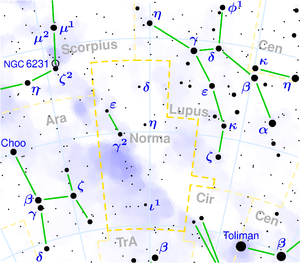 A small and fainter constellation of the southern sky that does not rise above the horizon at our latitudes. It lies along the galactic equator between the Lupus and the Ara in the region where the Milky Way is again split by the Great Rift. The constellation is located in a rich part of the Milky Way and is therefore a good destination for a binocular's walk across the sky. There is a striking star cloud here that is ivory white in colour. To the north of it, the Milky Way dissolves into an irregular and intricately complicated system interspersed with many brightenings and dark dust. The constellation's four brightest stars form a symmetrical trapezoid around which several open clusters are found. Two of them - NGC 6067 and 6087 - are usually visible as hazy patches without any optical aid. This small constellation is also lucky to have novae - one flared up here in 1893 and another appeared near here in 1920.
A small and fainter constellation of the southern sky that does not rise above the horizon at our latitudes. It lies along the galactic equator between the Lupus and the Ara in the region where the Milky Way is again split by the Great Rift. The constellation is located in a rich part of the Milky Way and is therefore a good destination for a binocular's walk across the sky. There is a striking star cloud here that is ivory white in colour. To the north of it, the Milky Way dissolves into an irregular and intricately complicated system interspersed with many brightenings and dark dust. The constellation's four brightest stars form a symmetrical trapezoid around which several open clusters are found. Two of them - NGC 6067 and 6087 - are usually visible as hazy patches without any optical aid. This small constellation is also lucky to have novae - one flared up here in 1893 and another appeared near here in 1920.
γ1 a γ2 Nor - Gamma2 Dor is the brightest star in the constellation with its apparent magnitude of 4.14. Gamma1 Dor forms an optical double star with it, which can be distinguished with the naked eye. Gamma2 Dor is an orange giant located 130 light-years away, and its companion with a magnitude of 5 is a bright white subgiant, which is more than 100 times farther away. Additionally, in a telescope, we can find a 10th magnitude companion at a separation of 45 arcseconds from Gamma2 Dor.
ε Nor - Nice double star composed of components with magnitudes 4.8 and 7.5, which are separated by 22.8". We can distinguish them even in a small telescope. Both components are also spectroscopic binaries.
ι1 Nor - A binary star with components of 4.6 and 8.1 magnitude, which can be resolved with a small telescope at a separation of 10.8 arcseconds. ι2 is not physically associated with it and lies slightly further away in the sky.
NGC 6087
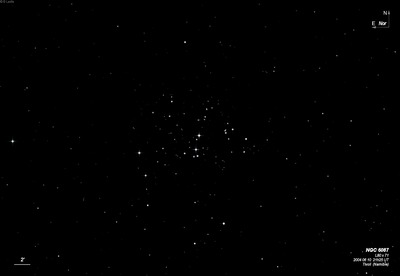
James Dunlop discovered NGC 6087 = D 335 = h3622 on 8 May 1826 and described "a group of very small stars of an irregular branched figure, 15' or 20' diameter. The central part is very thin of stars." Dunlop's position was 8' southeast of the center of the cluster.
John Herschel credited Dunlop with the discovery and made two observations: on 22 Apr 1835 he logged "Cluster VIII class, large, loose, brilliant, irregular figure, fills field, chief star about 7th mag taken." On a second sweep he called it "Cluster VIII; large, coarse, bright, fills field, stars 7, 8, 9, 10th mag; a star about 7th mag taken."
200/250mm - 8" (7/13/91 - Southern Baja): about three dozen stars mag 7-11 were resolved at 63x. Very bright, large, ~15' diameter. The cluster contains several bright stars, including S Normae (Cepheid that varies from 6.1-6.8 over 10 days) and three mag 8-9 stars just south. Many of the stars in the cluster form an arrowhead outline with the vertex at the north end. Also a bright string of stars is off the SW end of the arrowhead aligned N-S. Impressive cluster although there are no dense spots.
Notes by Steve Gottlieb
NGC 6067
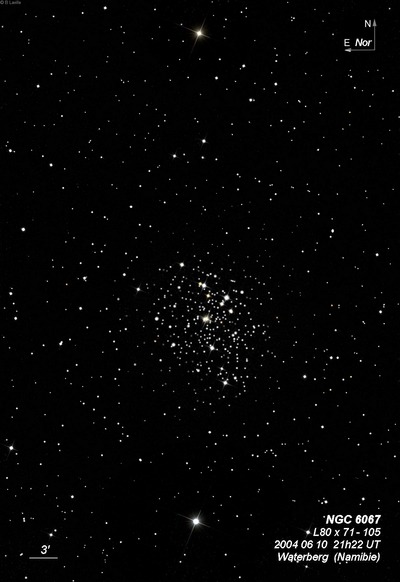
James Dunlop discovered NGC 6067 = D 360 = h3619 on 8 May 1826 and described "a pretty large cluster of small stars of mixed magnitudes, about 12' diameter; the stars are considerably congregated towards the centre, extended south preceding and north following." He made 5 observations of the cluster and his position is unusually accurate.
John Herschel made 3 observations: On 9 Jul 1834 he recorded "the chief star in middle of a most superbly rich and large cluster, 20' at least in diameter, as it much more than fills field; not much compressed in the middle, stars 10..12th mag." On a second sweep he called it "place of a near double star in centre of a superb cluster; very large and rich; composed of equal stars 12th mag, a fine object, Much more than fills field."
200/250mm - 8" (7/13/91 - Southern Baja): At 83x, in excess of 100 stars mag 8-12 in a 20' diameter. Very bright, large, very rich, compressed towards the core, which includes a striking double star at center (h4835 = 8.8/9.4 at 10"). Many stars are arranged in spirals and arcs, rich in faint stars. The brightest mag 7.8 star is located at the south edge with a mag 8 star off the east edge. This is a beautiful open cluster in the rich Norma starcloud!
400/500mm - 18" (7/6/05 - Magellan Observatory, Australia): at 76x (27 Panoptic), this cluster was a stunning sight with a few hundred stars sparkling in a 20' region. NGC 6067 appeared comparable to one the richer Messier clusters. The cluster is compressed towards the center and thins out in the periphery, blending in with the rich, surrounding Milky Way. The cluster includes a few striking pairs with a bright mag 8.8/9.4 pair at 10" near in the center, The duo is collinear with a much closer and fainter equal mag pair. At 228x, the cluster appeared much more irregular and most of the stars seemed to be arranged in elegant loops and chains that enclosed starless holes in the cluster.
Notes by Steve Gottlieb
NGC 6164
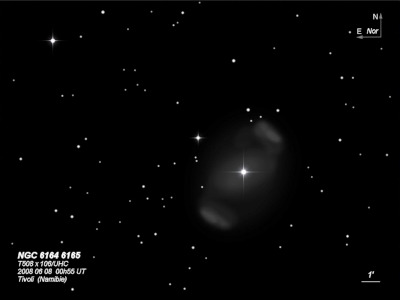
John Herschel discovered NGC 6164 = h3633 on 1 Jul 1834, along with NGC 6165, and recorded "Neb violently suspected immediately preceding a double star." His rough position (marked as approximate in RA and Dec (nearest arcmin)) is less than 2' south of the northwest wing of this large emission shell. NGC 6165 refers to the southeast wing.
Several older sources, including the RNGC, misclassify this object as a planetary nebula. The illuminating star is a massive, evolved O-star, losing mass from its outer layers through a strong stellar wind (similar mechanism to the Crescent Nebula = NGC 6188 and Thor's Helmet = NGC 2359).
400/500mm - 18" (7/8/02 - Magellan Observatory, Australia): this bipolar emission nebula was a startling sight at 171x and UHC filter! A bright illuminating star (HD 148937 at V = 6.8) is surrounded by two lobes or loops to the NW (NGC 6164) and SE (NGC 6165). Both loops contain brighter arcs symmetrically placed at the opposite ends. This is a large object, ~6' diameter, with the southeastern knot a bit brighter. A mag 9 star is 3' NE, outside the nebulosity. Located near the midpoint of mag 4.5 Epsilon Normae 1.3° NW and NGC 6188/6193 a similar distance SE.
600/800mm - 24" (4/11/08 - Magellan Observatory, Australia): this striking bi-polar nebula was quite impressive at 200x and UHC filter. The two bright loops or arcs are symmetrically placed along the rim, 2.6' NW and 3' SE of center with the southeastern arc brighter. The interior of the rim is filled with a fainter glow and the entire object forms a slightly elongated, 6.2'x5.2' oval. The nebula is dominated by the mag 6.8 central star (HD 148937). Mag 9 HD 148988 lies 3' NE of center.
Notes by Steve Gottlieb
NGC 6169
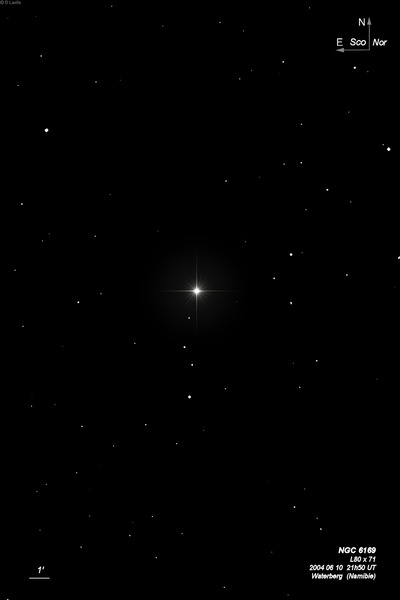
John Herschel discovered NGC 6169 = h3636 on 1 Jun 1834 and recorded "Cluster; place of a * Mu Normae in it."
The 1973 study by Vogt and Moffat "Southern Open Star Clusters III." (1973A&AS...10..135M) states "According to the Catalogue of Star Clusters and Associations this cluster has a diameter of 7' and is centered on the bright super-giant mu Nor. However, there is no obvious clustering here. To check this, three stars close to mu Nor were observed which show no genetic relation to one another or to mu Nor." A 2011 study ("A Catalog of 120 NGC Open Star Clusters") also found no CMD could be determined, so this group is an asterism.
400/500mm - 18" (4/5/16 - Coonabarabran, 139x and 236x): at low power a number of scattered stars surround mag 4.9 Mu Normae, but these are not eye-catching or cluster-like as the star density is high in this area, especially to the north and west. At 236x, a number of very faint stars surround Mu itself, particularly in a wreath-like shape on the north side and a east-west trending chain of mag 12-13.5 stars about 5' south. A nice triangle of mag 12 stars (sides ~1') lies 4' S of Mu.
Notes by Steve Gottlieb
NGC 6167
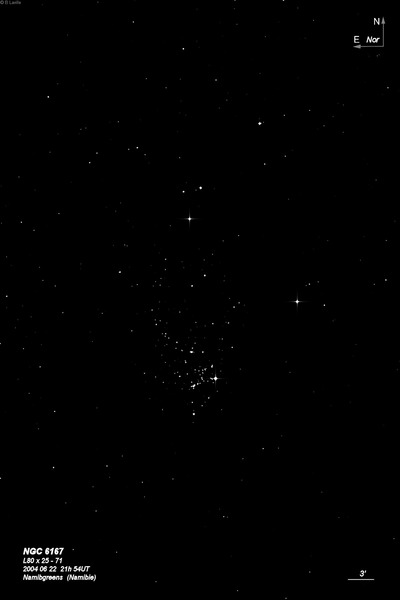
James Dunlop discovered NGC 6167 = D 400 = h3635 on 26 Jun 1826 with his 9-inch reflector from Parramatta, New South Wales. He recorded "a pretty large faint nebula, about 6' diameter, easily resolvable, round figure, with two rows of small stars following." His position is 13' northeast of center of the cluster. Apparently D 401 is a duplicate observation: "A very faint cluster of small stars, with a branch extended; the head of the cluster is rich in small stars." His position for D 401 is 16.5' east-southeast of the cluster and he notes 3 observations. JH recorded "a large irregular cluster of loose stars 11..14th magnitude which fills field; place that of an 8th magnitude star in the preceding part."
200/250mm - 8" (7/13/91 - Southern Baja): about 50 stars within a 10' diameter at 63x. Bright, fairly large, rich and pretty with both bright and faint stars. Includes many faint stars over unresolved haze. Includes curved arcs of stars and a nice string of stars to the south. The brightest mag 7.4 star is at the west side. Located on the Norma-Ara border.
400/500mm - 22" (6/28/06 - Hawaii): this bright cluster contains roughly 150 stars in a 10' region. The brightest mag 7.4 star (HD 14919) is on the west edge of the cluster and the richest region is just following this star. At the east edge of this rich group is a nice double star. Several curving strings and sprays of stars crisscross the cluster. NGC 6164/6165 lies 1.7° north.
Notes by Steve Gottlieb
NGC 6134
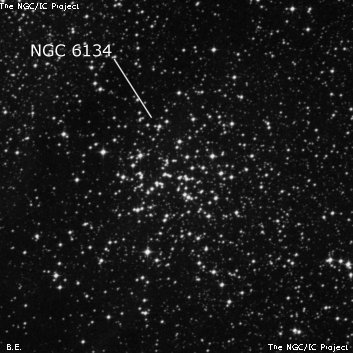
James Dunlop discovered NGC 6134 = D 412 = h3627 on 10 May 1826 and described as "a pretty large round nebula, about 4' diameter, gradually a little brighter towards the centre. There is a small star on the north, and another on the south side, both involved. This is easily resolved into stars, with slight compression to the centre." His position is 6' too far northeast.
On 5 Jul 1834, JH recorded "a pretty rich loose large, roundish cluster of stars 12..14th mag, 7' diameter, not m comp M." On 15 Apr 1836 he called it "VII class, rich, L, gradually a little compressed in the middle, irregularly round, 12', stars 13,14,15th mag, nearly fills field."
400/500mm - 18" (7/9/02 - Magellan Observatory, Australia): at 128x, NGC 6134 is a bright, fairly large open cluster, at least 10' diameter, with roughly 150 stars resolved from mag 10 and fainter. Many of the stars are arranged in chains, loops and rings although there was no central concentration. The brightest mag 9.3 star (HD 148076) is on the SE side of the cluster, about 4' from the center. The Norma Milky Way background is very rich in this region.
Notes by Steve Gottlieb
NGC 6152
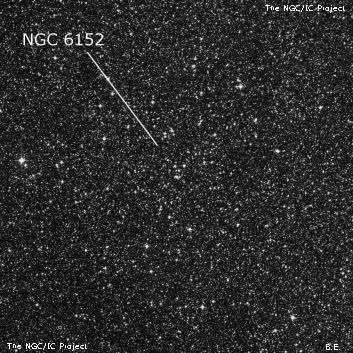
John Herschel discovered NGC 6152 = h3631 on 8 Jul 1834 and logged a large and coarse milky way cluster, tolerably insulated, composed of large stars." His position is near the center of this large cluster.
400/500mm - 18" (7/9/02 - Magellan Observatory, Australia): At 76x (27mm Panoptic), this is a large 30' cluster in a glorious Milky Way field. A couple of hundred stars generally mag 10 and fainter are resolved including a few dense clumps of stars. Many of the stars are arranged in loops and knots. A wide mag 8/10 pair is on the east side. The surrounding region is rich, so the cluster does no stand out except at low power.
Notes by Steve Gottlieb
NGC 5925
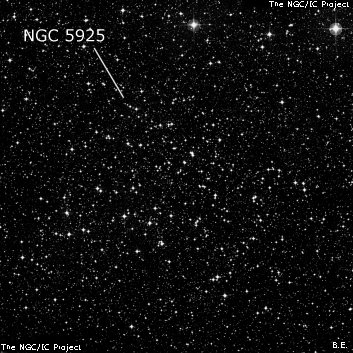
John Herschel discovered NGC 5925 = h3603 on 28 Jul 1826 and recorded "a most numerous and beautiful milky way group or cluster covering a space of 1.5 or 2 fields diameter (20' or 30') entirely composed of double and triple stars, and distinct groups of 4 or 5 nearly of a size (10th and 11th mag) on a black ground. Perhaps 100 or 150 stars in field." The next night he logged "a remarkable cluster, 20' diameter, R, very discrete, and composed of small groups of 2, 3, 4 stars, chiefly 11, 12 and 13th mag, sufficiently insulated from the rest of the pretty rich neighbourhood to be considered a cluster."
JH credited James Dunlop with the discovery (D 357), but Dunlop's position is a much better fit with NGC 5593 and an hour off in time from NGC 5925. Dreyer associated D 357 with both NGC 5593 and NGC 5925 in the NGC, so there was clearly some confusion.
400/500mm - 22" (6/28/06 - Hawaii): at 110x appears as a large, fairly rich cluster of ~150 stars mag 11 to 14 in a 25'x12' group (roughly rectangular) elongated SSW to NNE. Not concentrated and without any distinctive rich clumps, though many stars forming small subgroups. Situated in a rich region of the Milky Way and not distinguishable at moderate power but fairly detached using low power.
Notes by Steve Gottlieb
NGC 5946
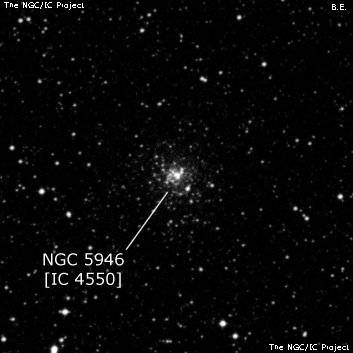
200/250mm - 8" (7/13/91 - Southern Baja): faint, very small, 1.5' diameter, round, almost even surface brightness with a weak concentration. A mag 12 star is at the WSW edge (field star). The core appeared displaced towards this star. No additional resolution was evident. Located in a rich star field with globular cluster NGC 5927 70' W. Viewed at about 14° elevation from Baja.
400/500mm - 18" (7/6/05 - Magellan Observatory, Australia): at 128x this globular appeared moderately bright, moderately large, round. The halo extends to 3' diameter with averted vision and surrounds a brighter 1' core. At 228x a number of very faint stars were just resolved around the periphery of the halo in moments of better seeing. Perhaps two dozen stars were resolved in total including a bright mag 12 star (superimposed field star?). Many of the resolved stars form a semi-circular loop, ringing the halo along the entire eastern half of the globular. Several mag 10-11 stars form a long chain curving around from the SW to the east side, ~5' from the cluster. NGC 5946 is situated within a beautiful Norma star field ~70' E of the brighter globular cluster NGC 5927.
Notes by Steve Gottlieb
NGC 6031
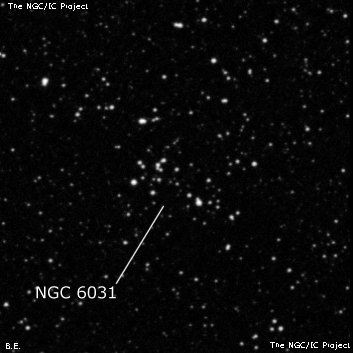
James Dunlop discovered NGC 6031 = D 359 = h3618 on 28 Jul 1826 and described "three very minute stars forming a triangle, with a faint round nebula, about 20 arcseconds diameter in the centre, but none of the stars are involved in the nebula." His position is 5' south of the cluster. JH made a single observation on 19 Jun 1835: "cluster, a small, compact knot of stars 11..14th mag, in a magnificently full field and zone."
400/500mm - 18" (4/5/16 - Coonabarabran, 236x): small, fairly rich cluster with 40-50 stars (with careful viewing) packed into a 2.5' region. The cluster is roughly triangular with vertices on the southwest, east and northeast ends. Contains a tight knot of 4-5 stars within 20". A close double star (mag 11 primary, separation <5") is 1' off the north end. Located 50' WNW of NGC 6067.
Notes by Steve Gottlieb
NGC 5999
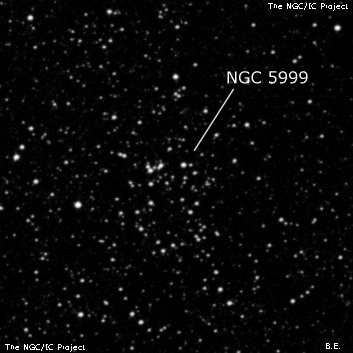
James Dunlop discovered NGC 5999 = D 343 = h3612 on 8 May 1826 and described "a pretty large faint nebula, with several minute stars in it; round figure, 4' or 5' diameter, resolvable." His position was off by ~10' west-southwest. JH made a single observation on 9 Jul 1834 and reported "cluster VI class. A pretty rich large cluster, round; little compressed in the middle, 12', stars 12..14th mag, nearly fills field; middle taken."
400/500mm - 18" (7/7/02 - Magellan Observatory, Australia): at 229x, this is a fairly rich, moderately large cluster. In the center is a striking elliptical ring of roughly two dozen stars. Surrounding this annulus is a larger loop of stars forming a heart-shaped asterism. The looping star patterns make this an interesting visual target! The diameter is roughly 8', though there is no distinct border.
Notes by Steve Gottlieb
NGC 6115
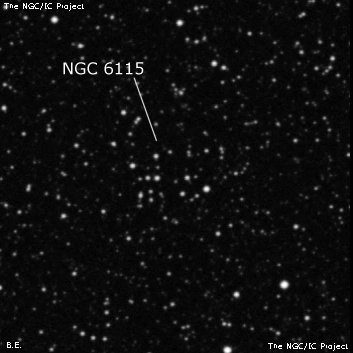
James Dunlop probably discovered NGC 6115 = D 379 = h3625 on 26 Jun 1826. He noted "a small faint round nebula, with a bright centre" and his position is just 5' northeast the cluster. John Herschel independently discovered NGC 6115 on 8 Jul 1834 and recorded "A part of the milky way, so immensely rich as to be one vast cluster of clusters." His single position matches Ru 118. Sky Catalogue 2000.0 labels the cluster as Ru 118 and RNGC misclassifies the NGC 6115 as nonexistent (Type 7).
400/500mm - 18" (4/5/16 - Coonabarabran, 236x): ~30 stars resolved in a small 3' cluster. The brightest mag 10.8 star is at the west edge and includes a number of mag 11.5-13 stars, mostly on the east side. This cluster is unimpressive, though, as it sits in a glorious rich Norma star field that overwhelms the cluster! Ruprecht 116, a scattered group of bright stars (brightest is mag 8.6 SAO 243732), lies 10' WSW.
Notes by Steve Gottlieb
Mz 2
| Type | PN [4(3)] |
| RA | 16:14:32.4 |
| Dec | -54:57:05.0 |
| major_axis | 24.0'' |
| minor_axis | 18.0'' |
| position_angle | 5.0 |
| mag | 11.9 |
| surface_bright | 9.5 |
Mz 1
| Type | PN [4(6)] |
| RA | 15:34:16.6 |
| Dec | -59:09:07.0 |
| major_axis | 48.0'' |
| mag | 12.5 |
| surface_bright | 11.8 |
Mz 3
| Type | PN |
| RA | 16:17:13.4 |
| Dec | -51:59:11.0 |
| major_axis | 24.0'' |
| mag | 13.8 |
| surface_bright | 11.6 |